
The 19th Century axiom that “plus ça change, plus c’est la même chose”* could have been thought up to describe race relations in the United States, or at least race relations as Bruce Norris writes about them in his Tony and Pulitzer Prize-winning play Clybourne Park, now getting its first San Diego production—and a splendid one at that—at San Diego REPertory Theatre.
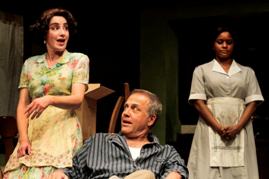 Norris’s early exposure to Lorraine Hansberry’s A Raisin In The Sun planted a germ in the young child’s head that would one day become the adult playwright’s Clybourne Park. Identifying racially with Raisin’s sole white character (the Community Association member bent on insuring that Hansberry’ African-American Younger family not move into his all-white neighborhood), preteen Norris dreamed of someday playing Karl onstage. Instead, he ended up writing a play that focuses Karl and on the Caucasian family whose house the Youngers were about to call their own.
Norris’s early exposure to Lorraine Hansberry’s A Raisin In The Sun planted a germ in the young child’s head that would one day become the adult playwright’s Clybourne Park. Identifying racially with Raisin’s sole white character (the Community Association member bent on insuring that Hansberry’ African-American Younger family not move into his all-white neighborhood), preteen Norris dreamed of someday playing Karl onstage. Instead, he ended up writing a play that focuses Karl and on the Caucasian family whose house the Youngers were about to call their own.
Taking place in that very house only hours after Karl’s visit to the Youngers, Clybourne Park’s first act starts out deceptively light, with 50something homeowner Russ finishing off a box of Neapolitan ice cream and wife Bev insisting over and over that the word Neapolitan could not possibly refer to Naples as Russ has suggested. Local minister Jim arrives, ostensibly for a friendly visit, though it soon becomes clear that Bev has asked him to check up on Russ, whose increasingly odd behavior of late has her worried about much more than simply the impending move. Helping Bev with the packing is African-American maid Francine, whose husband Albert shows up just in time for Bev to request his help in bringing down a heavy trunk from upstairs despite Francine’s repeated insistence that they need to be on their way.
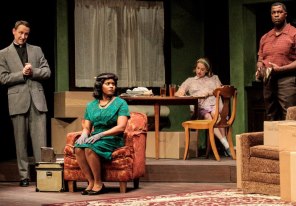 It’s precisely at this point of simmering black-and-white tension that Karl arrives with his very pregnant, very deaf wife Betsy, and before you know it, Russ and Bev’s house has become a microcosm of U.S. race relations circa 1959, and one that had this reviewer feeling quite satisfied by intermission at all the progress we Americans have made in the ensuing half century. After all, even our First Family is African-American!
It’s precisely at this point of simmering black-and-white tension that Karl arrives with his very pregnant, very deaf wife Betsy, and before you know it, Russ and Bev’s house has become a microcosm of U.S. race relations circa 1959, and one that had this reviewer feeling quite satisfied by intermission at all the progress we Americans have made in the ensuing half century. After all, even our First Family is African-American!
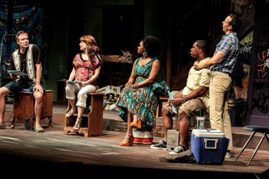 Then comes Act Two, set fifty years later, with a whole new cast of characters who don’t seem to be doing all that much better than their pre-Civil Rights Movement predecessors, and it became crystal clear that any notion of racial harmony would have to be thrown straight out the window.
Then comes Act Two, set fifty years later, with a whole new cast of characters who don’t seem to be doing all that much better than their pre-Civil Rights Movement predecessors, and it became crystal clear that any notion of racial harmony would have to be thrown straight out the window.
Despite the seriousness of the issues around which Clybourne Park revolves and the downright pessimistic conclusions its playwright seems to be drawing about the possibility of race relations ever getting that much better, Norris has written one of the most entertaining plays of recent years, with nearly as many laughs as a Neil Simon revival, a “spoonful of sugar” to “make the medicine go down” as it were. Some of these laughs come from the idiosyncrasies of Norris’s quirky characters, while others are more directly related to matters of race, including several jokes so politically incorrect that they provoke gasps of shock and peals of laughter in equal measure.
Though there are times when Norris seems to have bitten off a tad more than he can chew—the family tragedy which has sent Russ and Bev off to the suburbs and the way Norris uses it to bookend two very different acts ends up a bit “off topic”—it’s nonetheless easy to see why Clybourne Park has become both a critical and popular success with its combination of humor that makes us laugh and drama that gets us thinking and talking about more serious matters.
San Diego Rep Artistic Director Sam Woodhouse not only directs—assuredly and incisively so—but has assembled as gifted an acting ensemble as you’d find in any major theater town.
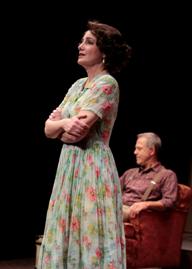 Four of the seven cast members (each of whom plays a different character in Acts One and Two) are San Diego-based actors whose work I have seen and admired before, and they don’t get any better than Sandy Campbell, Jason Heil, Jason Maddy, and Monique Gaffney. The same can be said for Mark Pinter, Matt Orduna, and Amanda Leigh Cobb, new to me but every bit as talented as their castmates.
Four of the seven cast members (each of whom plays a different character in Acts One and Two) are San Diego-based actors whose work I have seen and admired before, and they don’t get any better than Sandy Campbell, Jason Heil, Jason Maddy, and Monique Gaffney. The same can be said for Mark Pinter, Matt Orduna, and Amanda Leigh Cobb, new to me but every bit as talented as their castmates.
Playwright Norris couldn’t have gifted seven actors with more exciting, diverse pairs of roles to bring to life—Pinter’s moody, frustrated Russ and chatty, easygoing Dan, Campbell’s ditzy but deep Bev and the more down-to-earth Kathy, Maddy’s well-meaning Jim and cell-phone-oholic Tom, and Cobb’s sweet but clueless Betsy and “Half my friends are black” Lindsey. Heil gets the prime assignment of bringing to life the increasingly belligerent Karl (the one character featured in both A Raisin In The Sun and Clybourne Park) as well as the tell-it-like-it-is Steve. Finally, Gaffney and Orduna give us Francine and Albert, mid-20th Century “ Negroes” who do their best not to rock the racial boat, followed by their considerably prouder, considerably more outspoken 21st Century counterparts Lena and Kevin.
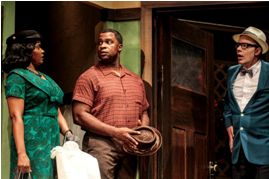 Scenic designer Robin Sanford Roberts has created a meticulously detailed home for Russ and Bev, and just wait till you see how fifty years have changed it when you come back from intermission. Jennifer Brawn Gittings’ costumes instantly reveal both the era in which they were designed and the character traits of the people who are wearing them, as do Missy Bradstreet’s wigs. Sherrice Kelly has created a subtly effective lighting design, while Tom Jones’s sound design not only features just-right ring-tone effects and the like but opens each act with a decade-appropriate recording of “Mack The Knife,” Bobby Darin’s and Michael Bublé’s if I’m not mistaken. Fight director George Yé knows how to make stage punches look pretty darn real and ASC Consultant Hillary Blaack has coached Heil and Cobb in American Sign Language. Dawn Moore is dramaturg and Heather M. Brose stage manager.
Scenic designer Robin Sanford Roberts has created a meticulously detailed home for Russ and Bev, and just wait till you see how fifty years have changed it when you come back from intermission. Jennifer Brawn Gittings’ costumes instantly reveal both the era in which they were designed and the character traits of the people who are wearing them, as do Missy Bradstreet’s wigs. Sherrice Kelly has created a subtly effective lighting design, while Tom Jones’s sound design not only features just-right ring-tone effects and the like but opens each act with a decade-appropriate recording of “Mack The Knife,” Bobby Darin’s and Michael Bublé’s if I’m not mistaken. Fight director George Yé knows how to make stage punches look pretty darn real and ASC Consultant Hillary Blaack has coached Heil and Cobb in American Sign Language. Dawn Moore is dramaturg and Heather M. Brose stage manager.
There’s so much more I could write about Clybourne Park but have refrained from doing in the interest of brevity. One thing is certain. If you’re down from L.A. as my guest and I were, you’ll be spending a good deal of the drive home recalling and rehashing Clybourne Park, and that’s about as good a reason for a day-trip down south as I can possibly imagine.
* the more it changes, the more it’s the same thing
The Lyceum Stage, San Diego REPertory Theatre, 79 Horton Plaza, San Diego.
www.sdrep.org
–Steven Stanley
January 20, 2012
Photos: Daren Scott


 Since 2007, Steven Stanley's StageSceneLA.com has spotlighted the best in Southern California theater via reviews, interviews, and its annual StageSceneLA Scenies.
Since 2007, Steven Stanley's StageSceneLA.com has spotlighted the best in Southern California theater via reviews, interviews, and its annual StageSceneLA Scenies.







 COPYRIGHT 2025 STEVEN STANLEY :: DESIGN BY
COPYRIGHT 2025 STEVEN STANLEY :: DESIGN BY